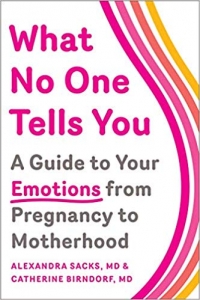
Parenting is hard sometimes. We might have a hyperactive inner critic that shines a floodlight on our parenting blunders without offering any suggestions about what to do differently with our kids. Or we might live far away from our extended families, who would otherwise be there to help us think through day-to-day challenges. Parenting books can be a source of ease and inspiration for how to approach parenting conundrums.
Our favorite parenting books of 2019 offer parents practical, research-based insights on how to help children feel more confident, calm, connected, cared for, and compassionate. They also offer women support with the emotionally intense, unchartered experience of becoming a mother. They shed light on complicated and difficult topics and provide doable suggestions with a spirit of optimism and encouragement—which is a comfort to parents who are often in short supply of both.
 Simon & Schuster, 2019, 400 pages. Read our Q&A with Alexandra Sacks.
Simon & Schuster, 2019, 400 pages. Read our Q&A with Alexandra Sacks.A lot of women find that becoming a mother is a complex experience, with bumps along the road that you didn’t anticipate. What’s more, you may feel isolated in experiencing challenges, discomfort, and ambivalence, assuming you’re the only one who doesn’t feel constant maternal bliss.
“Why didn’t anyone tell me it would be like this?” This is the question reproductive psychiatrists and coauthors Alexandra Sacks and Catherine Birndorf try to answer in What No One Tells You, their guidebook on “matrescence”—a unique transitional period in human development between when a woman becomes pregnant and when her child turns one.
What No One Tells You is mostly geared toward first-time mothers and walks you through the emotional experience of each trimester, beginning with finding out you’re pregnant and telling this news to others, handling body and relationship changes, and embracing your transforming identity. They offer guidance on preparing for the intensity of labor and delivery, including the possibility that you might experience different feelings than expected when meeting your baby for the first time. The book also supports women during early motherhood by explaining how to practice self-care and mindfulness, as well as how to nurture the multiple meaningful relationships in your life, including a healthy attachment with your baby and coparenting with a partner.
Sacks and Birndorf explain the differences among the “baby blues,” postpartum depression, postpartum anxiety, and matrescence, and they offer guidance on when and how to seek professional help. “You don’t have to choose between your motherhood and your mental health,” explain Sacks and Birndorf. “Mothers need proper mental health during pregnancy and the postpartum period, for their own heath and for their baby’s, because the wellness of a mother and child are inextricably connected.”
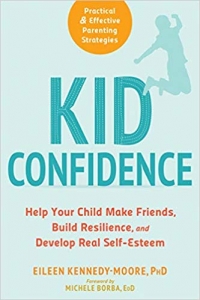 New Harbinger Publications, 2019, 240 pages. Read an essay adapted from Kid Confidence.
New Harbinger Publications, 2019, 240 pages. Read an essay adapted from Kid Confidence.We want to help our kids feel capable and self-assured. At the same time, we know that moments of self-doubt will creep up on them, and we hope that they are short-lived. But what can parents do if their kids are intensely and persistently plagued by low self-esteem?
In Kid Confidence, psychologist Eileen Kennedy-Moore helps parents of six to twelve year olds gain insight on what might be underlying their children’s negative self-regard and provides strategies to help them nurture greater confidence and resilience in their kids.
“The key to breaking from low self-esteem is to move beyond self-focus,” explains Kennedy-Moore. “Real self-esteem isn’t about believing we are special or wonderful. Real self-esteem means being able to let go of the question Am I good enough?” She encourages parents to help kids strive to develop a “quiet ego”—a state of being where they are listening to both themselves and others in order to live more humanely and compassionately.
She explains that parents can help their children do this by meeting three of their fundamental needs: for connection, competence, and choice. By cultivating deep relationships with friends and family, children are drawn away from being focused on themselves because they are immersed in caring for others. Kids who believe that they have the capacity to grow their competence will stick with learning things that are tough and avoid unhealthy striving for perfection. Finally, children who are empowered to make choices that reflect their personal values feel guided by an internal compass rather than helpless and out of control.
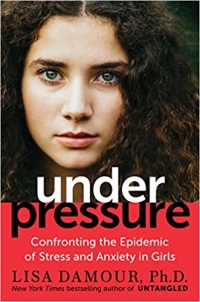 Ballantine Books, 2019, 288 pages. Read our review of Under Pressure.
Ballantine Books, 2019, 288 pages. Read our review of Under Pressure.In Under Pressure, psychologist Lisa Damour explains why unhealthy stress and anxiety are rising among girls. She points to research showing that, compared to boys, girls are more worried about school and their looks, suffer more from cyberbullying and its emotional fallout, and reach puberty sooner while witnessing hypersexual imagery on social media.
The focus of Under Pressure is how you can support girls in grappling with unhealthy stress and anxiety. Damour offers many recommendations, including encouraging you to help your daughters acknowledge and understand their uncomfortable feelings (like anger and sadness) rather than unintentionally diminish or divert them. She encourages us to help our daughters directly confront unhealthy stress and anxiety by asking two questions to take back the reins: “What is the source of all this stress?” and “Why am I anxious?”
You can also notice when you might pressure girls to say yes, particularly to things that are optional, and help them practice saying no. To help girls stand up for themselves, Damour suggests that you explain how it can be hard for them to be assertive because they are held to different standards than boys.
“The world asks more of our daughters than it ever has before, and it offers them more, too,” explains Damour. “As parents, we’re at our best when we help our girls advance, not retreat, in the face of the challenges and opportunities they will inevitably encounter.”
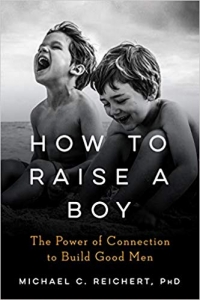 TarcherPerigee, 2019, 336 pages. Read our review of How to Raise a Boy.
TarcherPerigee, 2019, 336 pages. Read our review of How to Raise a Boy.“How can we protect the boys in our care from threats built into boyhood?,” asks Michael Reichert, a psychologist and author of How to Raise a Boy.
Reichert’s younger brother struggled with drinking and drugs as a teen, and was disconnected from his family and school; he died after a car accident when he was only 18 years old. When Reichert became a counselor in family court early in his career, he witnessed a number of delinquent boys grappling with destructive norms around masculinity, like expectations to be emotionally stoic, aggressive, and competitive in order to grow up to be “real men.” He continued to see similar patterns over 30 years working with and studying children.
Parents and societies need to raise boys differently, Reichert argues. He offers multiple recommendations that focus on helping boys develop strong relationships with family, teachers, and mentors. Chief among them, he encourages parents to nurture boys with love. Loving relationships are key for healthy development; without love, boys are more at risk to negative influences in their lives.
He recommends that parents listen to boys, show interest, and encourage them to express their emotions, making empathy the goal of listening so that boys know they’re cared for above all else. When boys are feeling difficult emotions like sadness or anger, parents can check their own reactions to see if they are actually discouraging their sons from being emotionally open. Reichert cautions, “If parents’ feelings frequently trump their ability to listen, boys will learn to stay away.” It can be hard to hear our children’s struggles without getting emotionally overwhelmed or offering advice, but this is the way to connect.
“Gaining insight into how feelings influence thinking and behavior is the defining skill in emotional intelligence,” explains Reichert. The emotional intelligence boys gain from expressing and processing feelings will serve them for the rest of their lives.
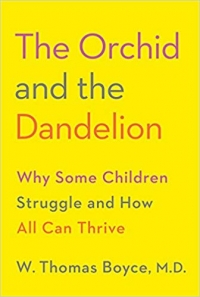 Knopf, 2019, 304 pages. Read our review of The Orchid and the Dandelion.
Knopf, 2019, 304 pages. Read our review of The Orchid and the Dandelion.The Orchid and the Dandelion begins with an autobiographical story of childhood best friends, a brother and sister, and how their lives diverged. “Why did my sister’s life consign her to growing desperation and an enduring, slow-moving catastrophe, while mine led to unanticipated and often undue success?” asks Dr. Thomas Boyce. “Why do some children struggle and others succeed?”
Boyce, a professor of pediatrics and psychiatry at the University of California, San Francisco, concludes from his and his colleagues’ research that kids have different patterns of physiological responses to their environments. On the one hand, some children are like dandelions and seem to be able to flourish in nearly any environment. On the other hand, some children are like orchids and seem to be especially sensitive to their environments—they are both extremely vulnerable in the face of adversity and can extraordinarily thrive in nurturing settings.
The hopeful message that Boyce leaves with the reader is that most children have dandelion qualities and are resilient to typical amounts of stress. What’s more, children with orchid qualities have the capacity to bloom beautifully if they are provided support and care. Boyce appeals to our collective moral responsibility to “provide the redemptive care and steadfast love that renders the weakest strong, the most fragile hearty, the least the best.”
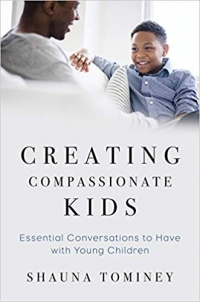 W. W. Norton & Company, 2019, 256 pages. Read an essay adapted from Creating Compassionate Kids.
W. W. Norton & Company, 2019, 256 pages. Read an essay adapted from Creating Compassionate Kids.Most parents hope their children will grow to be compassionate—the kind of people who notice when others are suffering and want to help them. And in turn, we hope they can turn to others who will do the same for them.
Teaching children about compassion can happen early on through conversations, according to Shauna Tominey, an assistant professor of practice and parenting education at Oregon State University, as well as a former early childhood educator and family service professional. “Helping children to be more compassionate does not necessarily mean teaching them to put themselves aside and put others first,” she explains. “It has to include teaching them the skills they need to manage their own well-being. After all, it’s hard to think about someone else’s feelings when you’re struggling to manage your own.”
Conversations can help children feel safe and cultivate trust, a loving foundation that will allow compassion to bloom. The most important first conversation to have with your kids conveys your love for who they are now and who they will grow to become. Tominey provides multiple examples of various conversations between parents and their children at different ages, from newborns to early school age. She follows each conversation with commentary and includes science-based insights.
Tominey also provides examples of conversations you can have with your kids about how you value their feelings, how they can count on you to teach them about the world, how to help them build self-awareness, and how to foster resilience. Finally, she offers guidance on conversations to promote compassion, including those around how to practice good manners, be a good friend, and make amends. She concludes each chapter with resources like children’s books, discussion questions, and family activities to continue the conversations.